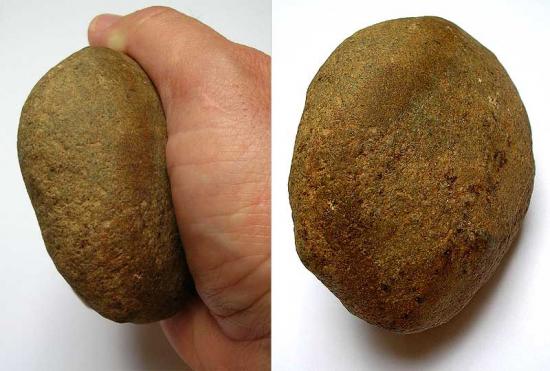Source - http://www.pasthorizonspr.com/index.php/archives/12/2013/ochre-hand-imprint-homo-erectus-revealed
Article courtesy of Alexander Binsteiner and Archäologie Online
Once again, the Homo erectus site of Lehberg near Haidershofen in the Lower Austrian part of the Enns (a southern tributary of the Danube River), is in the spotlight for Lower Palaeolithic research.
After the recent discovery of several well-preserved hand axes of Acheulean age dating to approximately 500,000 years ago, as well as a phallus shaped object coated with traces of ocre (see Fundsache Homo erectus, Archaeology Online 2012) a number of hammerstones were also recovered.
These hammerstones of oval quartzite and quartz cobbles come from the local Günz-gravels and have clear use marks on the longitudinal edges. However, after close examination, one of these stones revealed something quite remarkable.
Outline of a 500,000 year-old hand

During laboratory examination of the finds under a stereoscopic light microscope, a quartzite hammerstone was shown to have a peculiar line of reddish ochre along a well-defined and particularly striking side. Natural sediment retention in the cobble itself was excluded, and it suddenly became obvious that what was being observed, was the outline of the ball and thumb of a 500,000 year-old hand.
The use surface was compatible with it being held in such a way that the hand would have covered the rest of the cobble, leaving only a partial outline in red ochre, echoing the famous hand prints in the cave paintings of France and Spain.
The hammerstone user was right-handed and the resulting curved trace of colour on the stone was caused by trituration (the process for reducing particle size of a substance by grinding) of ochre with liquid, showing Homo erectus was undoubtedly using this as a form of paint at the site of Lehberg.
Constant use of the hammerstone in the same way and for the same purpose allowed the ochre particles to become ingrained along the same point where the hand would have rubbed against the stone.
Trace fossils
Generally known as trace fossils these transient negative imprints from the past include the dinosaur tracks of the the Jurassic and Cretaceous and the 3.6 million years old fossilised australopithecine footprints in volcanic ash of Laetoli near Olduvai Gorge in Tanzania, Africa.
The hand-prints from caves in France and northern Spain are associated in most cases with Homo sapiens and so fall into the remit of archaeology. However, this hand-print of Homo erectus, must be regarded as a trace of an extinct species and therefore a ‘trace fossil‘, putting it into the discipline of Palaeontology.
The impression from Lehberg will certainly not be a unique example, though it was found under unique circumstances but the future may require more attention to such phenomena that lies at the interface between archaeology and the geosciences or palaeontology.